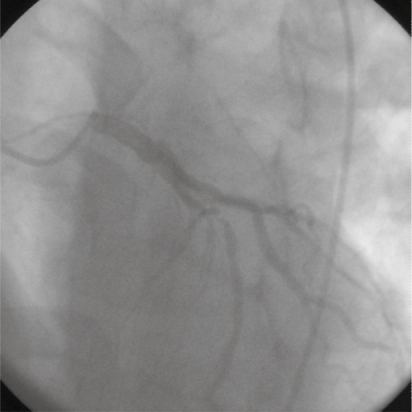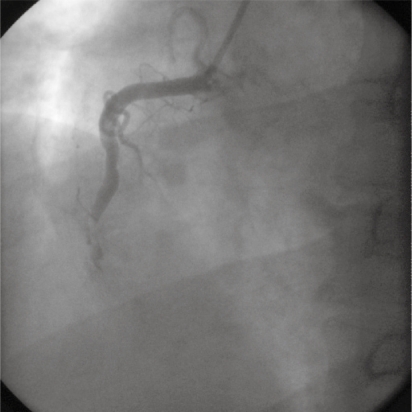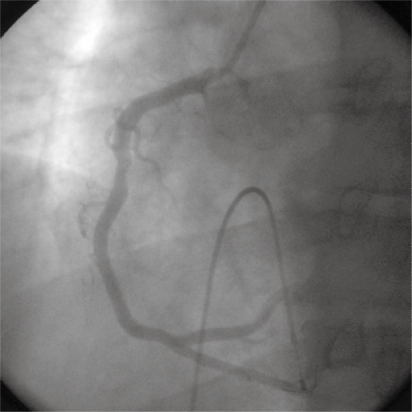Abstract
The association between testosterone-replacement therapy and cardiovascular risk remains unclear with most reports suggesting a neutral or possibly beneficial effect of the hormone in men and women. However, several cardiovascular complications including hypertension, cardiomyopathy, stroke, pulmonary embolism, fatal and nonfatal arrhythmias, and myocardial infarction have been reported with supraphysiologic doses of anabolic steroids. We report a case of an acute ST-segment elevation myocardial infarction in a patient with traditional cardiac risk factors using supraphysiologic doses of supplemental, intramuscular testosterone. In addition, this patient also had polycythemia, likely secondary to high-dose testosterone. The patient underwent successful percutaneous intervention of the right coronary artery. Phlebotomy was used to treat the polycythemia acutely. We suggest that the chronic and recent “stacked” use of intramuscular testosterone as well as the resultant polycythemia and likely increased plasma viscosity may have been contributing factors to this cardiovascular event, in addition to traditional coronary risk factors. Physicians and patients should be aware of the clinical consequences of anabolic steroid abuse.
Supraphysiologic doses of anabolic-androgenic steroids (AAS), which include more than 30 natural and synthetic derivatives of testosterone, may cause a wide spectrum of clinical sequalae. There have been a few case reports in the literature suggesting an association of intracoronary thrombosis, sudden death, myocardial necrosis, stroke and cardiomyopathy as possible sequelae of the use of supraphysiologic doses of anabolic steroids (CitationMcNutt et al 1988; CitationNieminen et al 1996; CitationDhar et al 2005).
The use of testosterone supplementation in physiologic doses has expanded in the last decade to include indications, such as stimulation of appetite in cachexia, improvement in libido and mood, as well as treatment of hypogonadism (CitationRhoden and Morgentaler 2004). Moreover, testosterone has been used in the treatment of reduced muscle mass and bone density as well as anemia. The role testosterone may play in the development of cardiovascular disease has increasingly become the subject of current interest (CitationChoi and McLaughlin 2007). Although the data for physiologic doses of testosterone replacement therapy have not demonstrated an increased incidence of cardiovascular event, long-term effects on cardiovascular health requires prospective, large-scale, randomized trials.
Testosterone stimulates erythropoiesis, particularly in high doses (CitationFried and Gurney 1968). Drastic elevations of hematocrit may be detrimental to patients with underlying coronary, cerebral or peripheral vascular disease by possibly causing an increase in blood viscosity (CitationBasaria and Dobbs 1999; CitationViallard et al 2000), and increased risk of thrombosis. We present a case of an acute inferior wall ST segment myocardial infarction in a patient using high dose testosterone with associated polycythemia.
Case report
A 44-year-old male without prior cardiac history presented with one day of intermittent exertional, substernal chest pain culminating in rest angina. He described associated features of left shoulder pain, shortness of breath and diaphoresis. He was taking high-dose intramuscular testosterone for the previous six weeks, and intermittently for two years. In addition, he was taking sildenafil occasionally. He was a recreational weight-lifter. His cardiac risk factors included tobacco abuse and family history of early coronary artery disease. There was no family history of lipid disorder. His physical examination was remarkable for his muscular appearance and a blood pressure of 190/100. He was in mild distress with no signs of heart failure. His blood chemistry revealed a creatinine of 1.3 mg/dl and elevated liver enzymes (aspartate aminotranferease 86 units/L, and alanine aminotransferase 79 units/L). Hematologic studies noted an hemoglobin of 22 g/dl and hematocrit of 63%. His platelet count was normal with a mildly elevated white blood count. His creatinine kinase (CK), CK-MB, and troponin were within normal limits on presentation. An electrocardiogram revealed sinus bradycardia, left ventricular hypertrophy, an acute inferior injury pattern with ST-segment elevation, and anterolateral ischemia. Ventricular bigeminy was also noted (). Emergent cardiac catheterization was then performed via the right femoral artery. Selective left coronary angiography revealed a diffusely diseased left anterior descending artery (LAD) with a 95% lesion after the takeoff of a small septal branch (). The circumflex artery was free of significant disease. Selective right coronary angiography revealed a total occlusion at the mid-portion of the vessel with intracoronary thrombus (). The patient underwent percutaneous transluminal coronary angioplasty (PTCA) and stent placement in the mid and distal right coronary artery vessel. The right coronary artery was notably a large, dominant vessel (). The procedure was complicated by distal embolization, treated with intracoronary adenosine and glycoprotein IIb/IIIa inhibitor, which resulted in some angiographic improvement. Clopidogrel (300 mg loading dose and 75 mg thereafter) was initiated immediately. The patient’s peak CK and CK-MB were 8830 units/L and 1800 units/L, respectively. A transthoracic echocardiogram demonstrated that the patient’s left ventricular systolic function was moderately reduced with inferior and inferoseptal akinesis, and inferolateral hypokinesis. The ejection fraction was 35%. Successful percutaneous intervention and stent placement were performed on the lesion in his left anterior descending artery on the following day. The patient was phlebotomized until his resultant hematocrit was 45%. Hematological workup for malignancy was negative. Total cholesterol was 219 mg/dl, low-density lipoprotein (LDL) cholesterol was 154 mg/dl, and high-density lipoprotein (HDL) 50 mg/dl. Standard medical therapy for acute myocardial infarction was initiated following the intervention and included aspirin, clopidogrel, beta-blocker, statin, and angiotensin converting enzyme inhibitor.
Figure 2 An anterior-posterior view of the left coronary system. The left anterior artery demonstrates a 95% stenosis after the first septal branch.

Discussion and review of the literature
Anabolic androgenic steroid use has increased over the past decade, despite its potential for adverse effects. They continue to be used by Olympic level athletes, and have even spread to high school level athletes, noncompetitive bodybuilders and recreational athletes (CitationSullivan et al 1998; CitationDhar et al 2007). Unfortunately, the data on the use of high dose anabolic steroids in humans are mainly offered as case reports or small studies that lack adequate control groups. In addition, the data available in the literature does not account for the steroid type(s) or dose, as neither may be known. Patients also may be taking concomitant stimulants, such as ephedra, which can confound data and the potential for adverse events. It is likely that the frequency of cardiac events is underreported in the medical literature.
Supplemental or physiologic doses of testosterone have noticed expanded use in medical practice recently. Testosterone is a potent ligand of the human androgen receptor and therefore, can modulate cellular functions such as transcription, translation and enzymatic function in skeletal and myocardial tissue. However, these functions can affect numerous other tissues. Other common potential adverse effects include infertility, hepatotoxicity, psychological abnormalities, and gynecomastia (CitationRhoden and Mortgentaler 2004).
Several case reports describe the deleterious cardiac effects of anabolic steroids including its potentially atherogenic and thrombotic properties. These range from lipid disorders to acute myocardial infarction and sudden cardiac death (CitationKennedy and Lawrence 1993; CitationHourigan et al 1998; CitationFineschi et al 2001; CitationWysoczanski et al 2008). Thromboembolic phenomenoma, intracardiac and peripherally, have been described (CitationMcCarthy et al 2000). Cardiomyopathy, cardiomegaly and biventricular dilatation have been associated with AAS use. CitationMewis and colleagues (1996) demonstrate a case report of a young bodybuilder with severe coronary artery disease with a two-year history of chronic anabolic steroid use. A case control study of 62 male competitive powerlifters notes a possible increase in premature mortality compared with controls (12.9% versus 3.1%) CitationParssinen et al 2000).
Potential mechanisms of cardiovascular toxicity of AAS include: atherogenic, thrombotic, vasospastic, and direct myocardial injury. The atherogenic model involves changes to lipid metabolism, including reductions in HDL levels and elevations in LDL (CitationMelchert and Welder 1995; CitationFeller et al 2003). Although difficult to quantitate, the increased risk of cardiac disease may be as high 3-fold among individuals who use AAS (CitationMelchert and Welder 1995; CitationSullivan et al 1998).
Development of an atheromatous plaque perpetuates endothelial dysfunction and promotes platelet aggregation and intracoronary thrombus formation (CitationAjayi et al 1995; CitationNieminen et al 1996). AAS may cause a hypercoagulable state, by an increase in production of thromboxane A2 and platelet thromboxane A2 receptor density as well as aggregation responses and a decrease in production of prostaglandins (CitationAjayi et al 1995). Moreover, a component of endothelial dysfunction has been proposed, which may contribute to abnormal vessel reactivity. However, testosterone in physiologic doses may even be beneficial in patients with angina (CitationEnglish et al 2000), have higher ischemic thresholds and improved quality of life (CitationMalkin et al 2004). Short-term intracoronary administration of testosterone induces coronary artery dilation and increases coronary blood flow in men with established coronary artery disease (CitationWebb et al 1999). Therefore, an interplay of endogenous factors of the patient’s risk profile as well as the testosterone dosing may be issues of whether adverse events occur.
Direct myocardial cell injury may occur by disruption of mitochondria and induction of intrafibrillar collagen dysplasia (CitationMelchert and Welder 1995; CitationSullivan et al 1998). Cellular injury results in fibrosis, which can be a potential nidus for ventricular arrhythmias. Patients commonly develop left ventricular hypertrophy, which may be related to hypertension, another adverse effect of AAS.
Erythrocytosis has been reported as a potential effect of testosterone, which can be beneficial in patients with anemia. However, dramatic elevations in hematocrit may be detrimental to patients with underlying coronary artery disease, as this may increase blood viscosity (CitationBasaria and Dobbs 1999; CitationViallard et al 2000). The greatest risk of erythrocytosis occurs with injectable forms of testosterone compared with transdermal preparations, especially in supraphysiologic doses. An increase of up to 44% of the baseline hematocrit has been reported (CitationDobs et al 1999).
We report for the first time an unusual case of an acute ST segment elevation myocardial infarction immediately following supraphysiologic “stacked” doses of intramuscular testosterone in a patient with known risk factors for coronary artery disease with associated dramatic polycythemia. We propose an association and potential interplay of traditional cardiovascular risk factors, high dose testosterone use, and possibly elevated plasma viscosity as possible contributors to this cardiovascular event (CitationBasaria and Dobbs 1999; CitationViallard et al 2000).
Disclosure
The authors report no conflicts of interest in this work.
References
- AjayiAALMathurRHalushkaPV1995Testosterone increase human platelet thromboxane A2 receptor density and aggregation responsesCirculation91274277758179
- BasariaSDobsAS1999Risks versus benefits of testosterone therapy in elderly menDrugs Aging151314210495072
- ChoiBGMcLaughlinMA2007Why men’s hearts break: cardiovascular effects of sex steroidsEndocrinol Metab Clin N Am3636577
- DharRStoutWLinkMS2005Cardiovascular toxicities of performance-enhancing substances in sportsMayo Clin Proc8013071516212144
- DobsASMeikleAWArverS1999Pharmacokinetics, efficacy, and safety of a permeation-enhanced testerosterone in comparison with bi-weekly injections of testerosterone enanthate for the treatment of hypogonadal menJ Clin Endocrinol Metab6434697810522982
- EnglishKMMandourOSteedsRP2000Men with coronary artery disease have lower levels of androgens than men with normal coronary angiogramsEur Heart J21890410806012
- EnglishKMSteedsRPJonesTH2000Low-dose transdermal testosterone therapy improves angina threshold in me with chronic stable angina: a randomized, double-blind, placebo-controlled studyCirculation10219061111034937
- FellerAAMylonakisERichJD2002Medical complications of anabolic steroidsMed Health R I853384012462865
- FineschiVBaroldiGMonciottiF2001Anabolic steroid abuse and cardiac sudden death: a pathologic studyArch Pathol Lab Med125253511175645
- FriedWGurneyCW1968The erythropoietic-stimulating effects of androgensAnn NY Acad Sci149356655240722
- HouriganLARainbirdAJDoorisM1998Intracoronary stenting for acute myocardial infarction (AMI) in a 24-year-old man using anabolic androgenic steroidsAust N Z J Med2883899972420
- KabakciGYidirirACanI1999Relationship between endogenous sex hormone levels, lipoproteins and coronary atherosclerosis in men undergoing coronary angiographyCardiology92221510844380
- KennedyMCLawrenceC1993Anabolic steroid abuse and cardiac deathMed J Aust15834688474379
- McNuttRAFerenchickGSKirlinPC1988Acute myocardial infarction in a 22-year-old world class weight lifter using anabolic steroidsAm J Cardiol621643381740
- MalkinCJPughPJMorrisPD2004Testosterone replacement in hypogonadal men with angina improves ischaemic threshold and quality of lifeHeart90871615253956
- McCarthyKTangATDalrymple-HayMJ2000Ventricular thrombosis and systemic embolism in bodybuilders:etiology and managementAnn Thorac Surg706586010969698
- MelchertRBWelderAA1995Cardiovascular effects of androgenic-anabolic steroidsMed Sci Sports Exerc271252628531623
- MewisCSpyridopoulosIKuhlkampV1996Manifestation of severe coronary heart disease after anabolic drug abuseClin Cardiol1915358821428
- NieminenMSRamoMPViitasaloM1996Serious cardiovascular side effects of large doses of anabolic steroids in weight liftersEur Heart J171576838909917
- ParssinenMKujalaUVartiainenE2000Increased premature mortality of competitive powerlifters suspected to have used anabolic agentsInt J Sports Med21225710834358
- RhodenELMorgentalerA2004Risks of testosterone-replacement therapy and recommendations for monitoringNew Engl J Med3504829214749457
- SullivanMLMartinezCMGennisP1998The cardiac toxicity of anabolic steroidsProg Cardiovasc Dis411159717856
- ViallardJFMaritGMercieP2000Polycythaemia as a complication of transdermal testosterone therapyBr J Haematol110237810931008
- WebbCMMcNeilJGHaywardCS1999Effects of testosterone on coronary vasomotor regulation in men with coronary heart diseaseCirculation1001690610525487
- WysoczanskiMRachkoMBergmannSR2008Acute myocardial infarction in a young man using anabolic steroidsAngiology59376818388062


